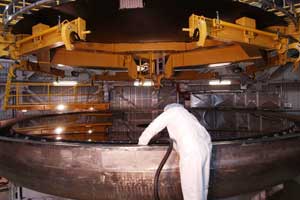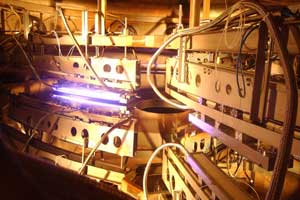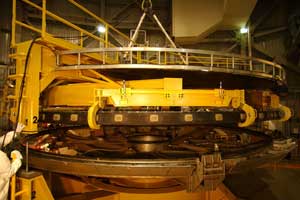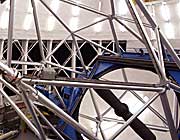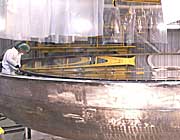 |
Contact Information |
|
Peter Michaud |
Antonieta Garcia Gemini Observatory, La Serena Chile 011-56-51-205-628 (Desk) Email: agarcia@gemini.edu |
|
Gemini Mirror is First With Silver LiningGemini Press Release (Embargoed Until June 9) |
||
Video Files Broadcast Quality NTSC/PAL and HDTV time-lapse footageTime-Lapse Video of Gemini South Silver Coating Process (Still shots taken from video)
Time-Lapse Video of Mirror Transport Into Telescope (Still shots taken from video)
Photos Full-Resolution images All Photos Gemini Obesrvatory/Kirk Pu'uohau-Pummill
Background Information on Gemini ObservatoryThe Gemini Observatory is an international collaboration that has built two identical 8-meter telescopes. The Frederick C. Gillett Gemini Telescope is located on Mauna Kea, Hawai`i (Gemini North) and the Gemini South telescope is located on Cerro Pachón in central Chile (Gemini South), and hence provide full coverage of both hemispheres of the sky. Both telescopes incorporate new technologies that allow large, relatively thin mirrors under active control to collect and focus both optical and infrared radiation from space. The Gemini Observatory provides the astronomical communities in each partner country with state-of-the-art astronomical facilities that allocate observing time in proportion to each country's contribution. In addition to financial support, each country also contributes significant scientific and technical resources. The national research agencies that form the Gemini partnership include: the US National Science Foundation (NSF), the UK Particle Physics and Astronomy Research Council (PPARC), the Canadian National Research Council (NRC), the Chilean Comisión Nacional de Investigación Cientifica y Tecnológica (CONICYT), the Australian Research Council (ARC), the Argentinean Consejo Nacional de Investigaciones Científicas y Técnicas (CONICET) and the Brazilian Conselho Nacional de Desenvolvimento Científico e Tecnológico (CNPq). The Observatory is managed by the Association of Universities for Research in Astronomy, Inc. (AURA) under a cooperative agreement with the NSF. The NSF also serves as the executive agency for the international partnership. |
